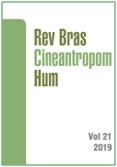Body fat, but not muscle quality, is related to perceived fatigue in young-adult active and inactive women
DOI:
https://doi.org/10.1590/1980-0037.2019v21e56093Abstract
The purpose of this study was to investigate the association of perceived fatigue with body composition and muscle quality (strength, thickness and specific torque) in young adult women. Fifty-one healthy women (31.98 ± 6.88 years) were assessed regarding perceived fatigue, body composition, knee extensors muscle strength, muscle thickness, and muscle quality. The short version of International Physical Activity Questionnaire was applied to classify subjects as active or inactive. To examine the relationship between perceived fatigue and dependent variables, the Pearson’s correlation was performed. Perceived fatigue was significantly correlated (p < 0.05) with body weight (r = 0.469), body mass index (r = 0.369), fat mass (r = 0.469), percent body fat (r = 0.396), and relative peak torque (r = -0.378). Additionally, inactive women had significantly greater (p < 0.05) body weight, body mass index, fat mass, percent body fat, and perceived fatigue than active women. Perceived fatigue is related to body weight and fat mass, but not to muscle strength or muscle quality. Moreover, physically active women showed lower perceived fatigue, body weight, and body fat compared to physically inactive women. These results suggest that body fat may play a role in perceived fatigue and physical activity could attenuate such symptom.
References
Enoka RM, Stuart DG. Neurobiology of muscle fatigue. J Appl Physiol (1985) 1992;72(5):1631-48.
Enoka RM, Duchateau J. Translating Fatigue to Human Performance. Med Sci Sports Exerc 2016;48(11):2228-38.
Saligan LN, Olson K, Filler K, Larkin D, Cramp F, Yennurajalingam S, et al. The biology of cancer-related fatigue: a review of the literature. Support Care Cancer 2015;23(8):2461-78.
Rimbaut S, Van Gutte C, Van Brabander L, Vanden Bossche L. Chronic fatigue syndrome an update. Acta Clin Belg 2016;71(5):273-80.
Sclerosis. Exerc Sport Sci Rev 2016;44(4):123-128.
Romano GF, Tomassi S, Russell A, Mondelli V, Pariante CM. Fibromyalgia and chronic fatigue: the underlying biology and related theoretical issues. Adv Psychosom Med 2015;34:61-77.
Silva JP, Pereira DS, Coelho FM, Lustosa LP, Dias JM, Pereira LS. Clinical, functional and inflammatory factors associated with muscle fatigue and self-perceived fatigue in elderly community-dwelling women. Rev Bras Fisioter 2011;15(3):241-8.
Tralongo P, Respini D, Ferrau F. Fatigue and aging. Crit Rev Oncol Hematol 2003;48(Suppl):S57-64.
Moreh E, Jacobs JM, Stessman J. Fatigue, function, and mortality in older adults. J Gerontol A Biol Sci Med Sci 2010;65(8):887-95.
Vantieghem S, Bautmans I, Tresignie J, Provyn S. Self-perceived fatigue in adolescents in relation to body composition and physical outcomes. Pediatr Res 2018;83(2):420-4.
Weisberg SP, McCann D, Desai M, Rosenbaum M, Leibel RL, Ferrante AW, Jr. Obesity is associated with macrophage accumulation in adipose tissue. J Clin Invest 2003;112(12):1796-1808.
Bournat JC, Brown CW. Mitochondrial dysfunction in obesity. Curr Opin Endocrinol Diabetes Obes 2010;17(5):446-52.
Segura-Jimenez V, Castro-Pinero J, Soriano-Maldonado A, Álvarez-Gallardo IC, Estévez-López F, Delgado-Fernández M, et al. The association of total and central body fat with pain, fatigue and the impact of fibromyalgia in women; role of physical fitness. Eur J Pain 2016;20(5):811-21.
Baptista RL, Biasoli I, Scheliga A, Soares A, Brabo E, Morais JC, et al. Psychometric properties of the multidimensional fatigue inventory in Brazilian Hodgkin's lymphoma survivors. J Pain Symptom Manage 2012;44(6):908-15
Cadore EL, Izquierdo M, Conceicao M, Radaelli R, Pinto RS, Baroni BM, et al. Echo intensity is associated with skeletal muscle power and cardiovascular performance in elderly men. Exp Gerontol 2012;47(6):473-8.
Bottaro M, Russo AF, Oliveira R. The Effects of Rest Interval on Quadriceps Torque During an Isokinetic Testing Protocol in Elderly. J Sports Sci Med 2005;4(3):285-90.
Gauche R, Gadelha AB, Paiva FML, Oliveira PFAd, Lima RM. Strength, muscle quality and markers of cardiometabolic risk in older women. Rev BrasCineantropom Desempenho Hum 2015;17(2):186-94.
Fernández-Sánchez A, Madrigal-Santillán E, Bautista M, Esquivel-Soto J, Morales-González A, Esquivel-Chirino C, et al. Inflammation, Oxidative Stress, and Obesity. Int J Mol Sci 2011;12(5):3117-32.
Dutra MT, Avelar BP, Souza VC, Bottaro M, Oliveira RJ, Nóbrega OT, et al. Relationship between sarcopenic obesity-related phenotypes and inflammatory markers in postmenopausal women. Clin Physiol Funct Imaging 2017;37(2):205-210.
Reid MB. Reactive Oxygen Species as Agents of Fatigue. Med Sci Sports Exerc 2016;48(11):2239-46.
Pataky Z, Armand S, Muller-Pinget S, Golay A, Allet L. Effects of obesity on functional capacity. Obesity (Silver Spring) 2014;22(1):56-62.
American College of Sports Medicine A. ACSM's guidelines for exercise testing and prescription. Lippincott Williams & Wilkins; 2013.
Silva AO, Karnikowski MG, Funghetto SS, Stival MM, Lima RM, Souza JC, et al. Association of body composition with sarcopenic obesity in elderly women. Int J Gen Med 2013;6:25-29.
Moratalla-Cecilia N, Soriano-Maldonado A, Ruiz-Cabello P, Fernández MM, Gregorio-Arenas E, Aranda P, et al. Association of physical fitness with health-related quality of life in early postmenopause. Qual Life Res 2016;25(10):2675-81.
Beyer I, Njemini R, Bautmans I, Demanet C, Bergmann P, Mets T. Inflammation-related muscle weakness and fatigue in geriatric patients. Exp Gerontol 2012;47(1):52-59.
Kennedy-Armbruster C, Evans EM, Sexauer L, Peterson J, Wyatt W. Association among functional-movement ability, fatigue, sedentary time, and fitness in 40 years and older active duty military personnel. Mil Med 2013;178(12):1358-64.
Singer S, Kuhnt S, Zwerenz R,Eckert K, Hofmeister D, Dietz A, et al. Age-and sexstandardised prevalence rates of fatigue in a large hospital-based sample of cancer patients. Br J Cancer 2011;105(3):445-51.
Gadelha AB, Paiva FM, Gauche R, de Oliveira RJ, Lima RM. Effects of resistance training on sarcopenic obesity index in older women: A randomized controlled trial. Arch Gerontol Geriatr 2016;65:168-173.
Chin SH, Kahathuduwa CN, Binks M. Physical activity and obesity: what we know and what we need to know. Obes Rev 2016;17(12):1226-44.
Strasser B, Arvandi M, Siebert U. Resistance training, visceral obesity and inflammatory response: a review of the evidence. Obes Rev 2012;13(7):578-91.



